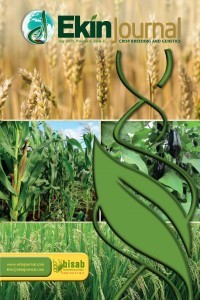Development of Turkish Potato Varieties Tolerance to Potato Virus Y and Potato Virus X
Development of Turkish Potato Varieties Tolerance to Potato Virus Y and Potato Virus X
breeding molecular marker, potato, PVY,
___
- Ahmadvand R, Wolf I, Gorji AM, Polgár Z and Taller J (2013). Development of molecular tools for dis tinguishing between the highly similar Rx1 and Rx2 PVX extreme resis tance genes in tetraploid potato. Pot Res 56: 277-291.doi:10.1007/s11540- 013-9244-y.
- Anonymous, 2014. http://www.fao.org/faos tat/en/#data/ QC (09 October 2017).
- Asano K and Tamiya S (2016). Breedingof pes t and disease resis tant potato cultivars in Japan by using classical and molecular approaches. Japan Agric. Research Quarterly 50(1): 1-6. doi: 10.6090/jarq.50.1.
- Babu R, Nair SK, Prasanna BM and Gupta HS (2004). Integrating marker-assis ted selection in crop breeding-prospects and challenges. Cur Sci 87:607-619.
- DeJong W, Forsyth A, Leis ter D, Gebhardt C and Baulcombe DC (1997). A potato hypersensitive resis tance gene agains t potato virus X maps to a resis tance gene clus ter on chromosome 5. Theor Appl Genet 95(1–2): 246-252.
- Gebhardt C (2005). Potato genetics: molecular maps and more. In: Molecular marker sys tems in plant breeding and crop improvement. Springer, New York. pp. 215-227.
- Gebhardt C, Bellin D, Henselewski H, Lehmann W, Schwarzfischer J and Valkonen JPT(2006). Marker assis ted combination of major genes for pathogen resis tance in potato. Theor Appl Genet 112: 1458-1464.doi: 10.1007/s00122-006-0248- 8. Gebhardt C (2013). Bridging the gap between genome analysis and precision breeding in potato. Trends Genet 29: 248-256.doi: 10.1016/j. tig.2012.11.006.
- Gopal J (2015). Challenges and way-forward in selection of superior parents, crosses and clones in potato breeding. Pot Res 58: 165-188.
- Haase NU (2003). Es timation of dry matter and s tarch concentration in potatoes by determination of under-water weight and near infrared spectroscopy. Pot Res 46(4): 117-127. doi: https://doi.org/10.1007/BF02736081.
- Kasai K, Morikawa Y, Sorri VA, Gebhardt C, Valkonen JPT and Watanable KN (2000). Development of SCAR markers to the PVY resis tance gene Ryadg based on a common feature of plant disease resis tance genes. Genome 43: 1-8.doi: 10.1139/ g99-092.
- Matsubayas thi M (1991). Phylogenetic relationships in the potato and its related species. In: Tsuchiya T, Gupta PK (eds) Chromosome engineering in plants: Genetics, breeding, evolution. Part B. Elsevier, Ams terdam, pp 93-118.
- Ohbayashi K, Nakata N, Chaya M and Komura K (2010). Development of a detection method of resis tance to potato disease and pes t using DNA markers. 1. Detection methods of resis tance to potato virus X, potato cys t nematode and late blight. Bull Nagasaki Agri Fore Technol Dev Cen 1:1-26.
- Ramakrishnan AB, Ritland CE, Sevillano RHB and Riseman A (2015). Review of Potato Molecular Markers to Enhance Trait Selection. American Journal of Potato Research 92: 455-472. doi:10.1007/s12230-015-9455-7
- Ross H (1986). Potato breeding -problems and perspectives. Adv Plant Breed 13:132.
- Slater AT, Cogan NOL, Hayes B, Schultz L, Dale MFB, Bryan GJ and Fors ter JW (2014.) Improving breeding efficiency in potato using molecular and quantitative genetics. Theor Appl Genet127: 2279-229.doi: 10.1007/s00122-014-2386-8.
- Slater AT, Cogan NOL, Rodoni B, Daetwyler H, Hayes B, Caruana B, Badenhors TP, Spangenberg G, and Fors ter J (2017). Breeding differently-The digital revolution: High throughput phenotyping and genotyping. 20th EAPR Triennial Conference, Paris France, 9-14 July 2017.
- Xu Y, Crouch JH (2008). Marker-assis ted selection in plant breeding: from publications to practice. Crop Sci 48: 391-407. doi: 10.2135/ cropsci2007.04.0191
- ISSN: 2149-1275
- Yayın Aralığı: Yılda 2 Sayı
- Başlangıç: 2015
- Yayıncı: Bitki Islahçıları Alt Birliği
Improving Grain Quality in Pulses: S trategies to Reduce Raffinose Family Oligosaccharides in Seeds
Udhaya KANNAN, Roopam SHARMA, Manu P. GANGOLA, Ravindra N. CHIBBAR
Development of Turkish Potato Varieties Tolerance to Potato Virus Y and Potato Virus X
Ercan OZKAYNAK, Zubeyir DEVRAN, Erdem KAHVECI
The Determination of Silage Yield and Quality Traits of Candidate Maize Hybrids
Erkan OZATA, Saime UNVER İKİNCİKARAKAYA, Ahmet OZTURK
Determination of High Oleic Type and Broomrape Resis tant Sunflower Hybrids By DNA Markers
Behiye Banu BILGEN, Sheida DANESHVAR, Goksel EVCI, Veli PEKCAN, Mehmet İbrahim YILMAZ, Yalcin KAYA
Organic Tea Production and Tea Breeding in Turkey: Challenges and Possibilities
Fatih SEYIS, Emine YURTERI, Aysel OZCAN, Yusuf SAVSATLI
Mustafa YILDIRIM, Zoltan BEDO, Marta MOLNÁR-LÁNG
In Vitro Tissue Culture S tudies in Sunflower (Helianthus spp.)
